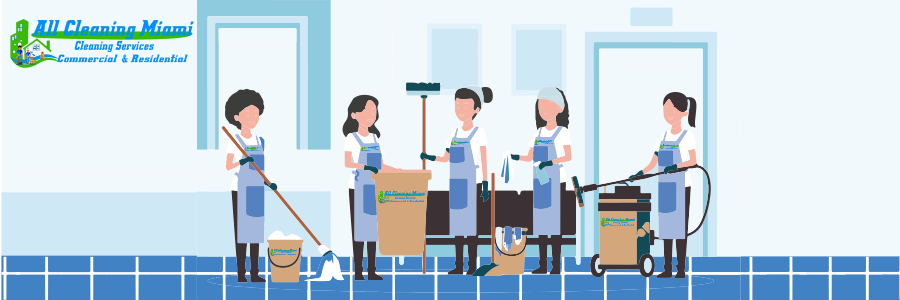
If you are looking for cleaning services for your clinic, health center, or nursing home in Miami, you have come to the right place. All Cleaning Miami is a cleaning service company that specializes in the cleaning of health clinics and nursing homes. We have qualified cleaning staff to perform any cleaning service with great care and attention to detail, as these environments are essential for promoting health and well-being.
At All Cleaning Miami, our mission is to provide you with the best cleaning service for your clinic or nursing home at a reasonable price while maintaining the highest level of quality. We offer customized plans to fit your specific needs and have highly trained professionals to ensure a healthy and hygienic environment for both employees and patients. Our service will create a positive change in your facility by maintaining a clean and attractive environment.
Our clinical experts are constantly training to provide the most current and effective cleaning solutions. Our experienced professionals have in-depth knowledge of the latest green cleaning products, equipment, and techniques, and are able to handle a variety of clinic cleaning tasks, including:
At All Cleaning Miami, we understand the importance of maintaining a healthy and clean workplace. Our staff is dedicated to keeping your office or clinic free of bacteria and odors through thorough deep cleaning at an affordable cost without sacrificing the quality of service. When you choose us, you can trust that we will provide a professional service with a clear vision of comprehensive health and well-being.
Environmental surfaces can be divided into two categories: those with clinical contact and those with lower levels of care. Clinical contact surfaces may come into direct contact with patient material during dental procedures, either through direct spray or splash, or through the gloves of dental staff. These surfaces have the potential to contaminate other tools, equipment, hands, or gloves. On the other hand, cleaning surfaces such as walls, floors, and sinks do not come into direct contact during dental treatment and pose a lower risk of disease transmission.
Disinfectants are used to kill or inactivate harmful microorganisms on surfaces and objects. There are various types of disinfectants available, each with their own level of effectiveness and suitability for certain situations. Some of the different types of disinfectants include:
It's important to choose the appropriate disinfectant for your needs, as using the wrong type of disinfectant may not be effective at killing the microorganisms you are trying to eliminate. Always follow the instructions on the disinfectant product label, and be sure to use it in a well-ventilated area.
There are several types of disinfectants available for use, including quaternary ammonium compounds, chlorine compounds, hydrogen peroxide, and alcohol. Each type of disinfectant has its own specific properties and effectiveness against different types of microorganisms. It is important to choose the right disinfectant for the specific surface or situation, as some disinfectants may not be suitable for certain materials or environments.
Disinfection removes most microorganisms and other microorganisms by physical or chemical means. In contrast, sterilization kills all microorganisms, including large numbers of resistant bacterial spores, through heat (steam autoclaving, dry heat, and unheated chemical vapors) or liquid chemical sterilants. Disinfection does not guarantee the safety associated with sterilization processes. It is important to understand the differences between these processes and choose the appropriate method for the specific situation to ensure the proper level of decontamination.
Cleaning is an essential step in any decontamination process. It removes visible organic compounds, dirt, and salts that can interfere with the effectiveness of microbial inactivation. By physically contacting surfaces with detergents and washing with water, we can kill various microorganisms and neutralize bacterial activity. If a surface is not cleaned properly before sterilization, the process may not be successful. Therefore, it is important to thoroughly clean surfaces, including removing visible blood and other organic and inorganic substances, in order to ensure their proper decontamination. If a surface cannot be adequately cleaned, it may need to be protected with barriers.